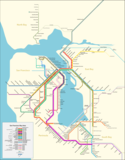The death of Ancient Rome wasn’t so much a collapse as a slow, interminable decay: between the second and sixth centuries AD, its population declined from a million people to just 30,000. read more »
Suburbs
The Ghost of Ancient Rome Haunts America
- Login to post comments
The Future of Cities: The Urban Future – The Great Dispersion
This chapter describes general urbanization trends in the United States and around the world, from 1950 to the present. Cities can be glamorous or exciting, but what matters most is how they facilitate higher incomes and standards of living. read more »
- Login to post comments
Welcome to Austin
I'm going to make a little deviation from the bulk of the "Welcome to..." stories you see below, which mostly focus on South Side Chicago neighborhoods (the exceptions are Rosemont, in Chicago's northwest suburbs, and Park Forest, in the south suburbs). read more »
- Login to post comments
Will Amtrak Benefit from Telecommuting?
Airlines carried 94 percent as many passengers in September 2022 as they did in September 2019, according to passenger counts published by the Transportation Security Administration. That’s up from 91 percent in August and 88 percent in September. read more »
- Login to post comments
A Better Future
In earlier times, even with a soaring population, Americans knew how to accommodate housing demand. In the eighteenth and nineteenth centuries we built cities from scratch along the frontier. The existing major urban centers—Boston, New York, Baltimore, Philadelphia—all expanded rapidly, both by density and expansion into land on the periphery. read more »
- Login to post comments
Is America Entering a New Age of Democratic Capitalism?
Most everyone outside the Biden administration knows that a recession is now more than likely. We could be entering what economist Noriel Roubini describes as the “Great Stagflation: an era of high inflation, low growth, high debt and the potential for severe recessions.” Certainly, weak growth numbers, declining rates of labor participation and productivity rates falling at the fastest rate in a half century are not harbingers of happy times. read more »
- Login to post comments
Pandemic Increases Homeownership
The nation’s number of occupied homes grew by 3.9 percent between 2019 and 2021, representing 4.7 million units of new homes read more »
- Login to post comments
U.S. Auto Commuting Dips to Half Century Low
The share of workers commuting to work by auto fell to 75.6%, according to the 2021 American Community Survey (ACS), the lowest level since before the 1970 census, which reported that 77.7% of commuting was by auto (Figure 1). read more »
Class Homicide
There’s much talk today, from left and right, about threats to democracy, yet little focus on the social dynamic critical to its survival. In this respect, we may see the current, and troubling, escalation of violent political rhetoric, and even political violence, not so much as the cause of polarization but the result of changing class dynamics, most notably the increasingly perilous state of the yeoman middle class. read more »
- Login to post comments
Migratory Millennials - Marching from the Metropolis
As stories of new migration patterns and movement across Australia’s cities and regions abound, updated population data shows that what initially appeared to be a pandemic-induced blip is instead the beginning of a reversal of a long-term trend. read more »
- Login to post comments






















